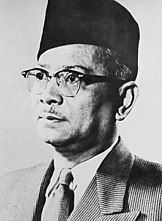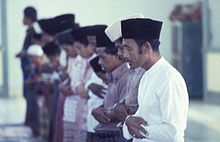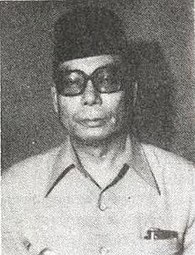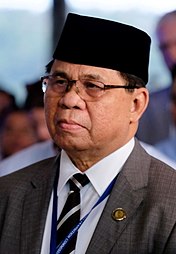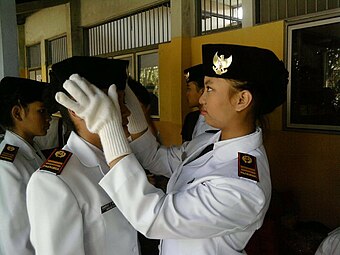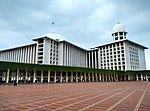
Silat Melayu, also known as Seni Persilatan Melayu or simply Silat, is a combative art of self-defence from the Malay world, that employs langkah ('steps') and jurus ('movements') to ward off or to strike assaults, either with or without weapons. Silat traced its origin to the early days of Malay civilisation, and has since developed into a fine tradition of physical and spiritual training that embodies aspects of traditional Malay attire, performing art and adat. The philosophical foundation of modern Malay Silat is largely based on the Islamic spirituality. Its moves and shapes are rooted from the basis of Silat movements called Bunga Silat, and Silat performances are normally accompanied with Malay drum assembles.

Malays are an Austronesian ethnoreligious group native to eastern Sumatra, the Malay Peninsula and coastal Borneo, as well as the smaller islands that lie between these locations. These locations are today part of the countries of Malaysia, Indonesia, the southern part of Thailand, Singapore and Brunei Darussalam.

The fez, also called tarboosh/tarboush, is a felt headdress in the shape of a short, cylindrical, truncated (peakless) hat, usually red, typically with a black tassel attached to the top. The name "fez" may refer to the Moroccan city of Fez, where the dye to color the hat was extracted from crimson berries. However, its origins are disputed.

A folk costume expresses a national identity through clothing or costume, which is usually associated with a specific region or period of time in history. It can also indicate social, marital, or religious status. If the costume is used to represent the culture or identity of a specific ethnic group, it is usually known as ethnic costume. Such costumes often come in two forms: one for everyday occasions, the other for traditional festivals and formal wear. The word "costume" in this context is sometimes considered pejorative due to the multiple senses of the word, and in such cases "clothing", "garments" or "regalia" can be substituted without offense.

A sarong or a sarung is a large tube or length of fabric, often wrapped around the waist, worn in Southeast Asia, South Asia, Western Asia, Northern Africa, East Africa, West Africa, and on many Pacific islands. The fabric often has woven plaid or checkered patterns, or may be brightly colored by means of batik or ikat dyeing. Many modern sarongs have printed designs, often depicting animals or plants. Different types of sarongs are worn in different places in the world, notably the lungi in the Indian subcontinent and the izaar in the Arabian Peninsula.
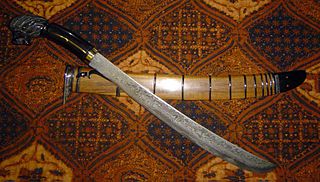
A golok is a cutting tool, similar to a machete, that comes in many variations and is found throughout the Malay archipelago. It is used as an agricultural tool as well as a weapon. The word golok is used in Indonesia and Malaysia. Both in Malaysia and in Indonesia, the term is usually interchangeable with the longer and broader parang. In the Sundanese region of West Java it is known as bedog. In the Philippines, the term gulok, refers to different dagger weapons including the kris.
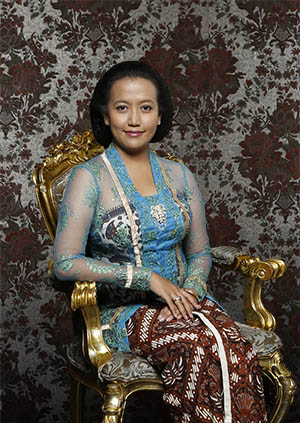
A kebaya is an upper garment traditionally worn by women in Southeast Asia, notably in Brunei, Indonesia, Malaysia, Singapore and Southern Thailand. It is also worn in parts of southern Philippines and Cambodia.
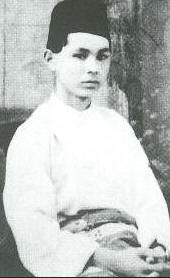
Baju Melayu is a traditional Malay costume for men, originated from the court of Malacca Sultanate and is traditionally worn by men in Brunei, Malaysia, Singapore, parts of Indonesia, southern Philippines, and southern Thailand. In its formal form, Baju Melayu is the national dress of Malaysia and Brunei, typically worn during official events and functions.

Pakaian is the term for clothing in Malaysia's national language. It is referring to things to wear such as shirts, pants, shoes etc. Since Malaysia is a multicultural nation: Malay, Chinese, Indian and hundreds of other indigenous groups of Malay peninsula and Borneo, each has its own traditional and religious articles of clothing all of which are gender-specific and may be adapted to local influences and conditions. Previously, traditional clothes were worn daily. However, by excluding Baju Melayu, Baju Kurung many are now only worn on special occasions such as marriage ceremonies and cultural events.
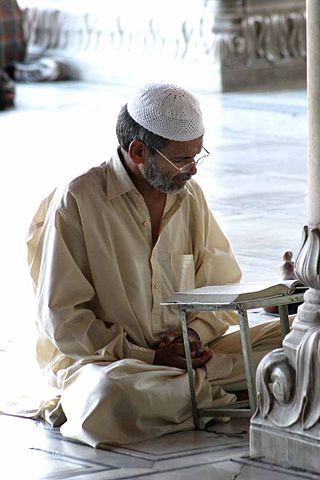
The Taqiyah, also known as tagiyah or araqchin, is a short, rounded skullcap worn by Muslim men. In the United States and the United Kingdom, it is also referred to as a "kufi". Aside from being an adornment, the taqiyah has deeply ingrained significance in Islamic culture, reflecting the wearer's faith, devotion, and sometimes regional identity. While the taqiyah is deeply rooted in Muslim traditions, its use varies based on cultural context rather than strict religious guidelines.

Kedahan Malays or commonly known as Orang Utara ('Northerners'), are a sub-group of Malays native to northern Malay Peninsula in areas of both current and historical area of Kedah. They are among the oldest ethnic groups in the Malay peninsula with a history dating back 2,800 years as proven by the discovery of sites in Bujang Valley and historical documents from India, China and Arabia. Kedahan Malays are one of the largest Malay sub-groups in Malaysia, comprising at least 15% of the total Malaysian Malay population including those with Kedahan ancestry.

Malaysian literature is the collection of literary works produced in the Malay peninsula until 1963 and in Malaysia thereafter. Malaysian literature is typically written in any of the country's four main languages: Malay, English, Chinese and Tamil. It portrays various aspects of Malaysian life and comprises an important part of the culture of Malaysia.
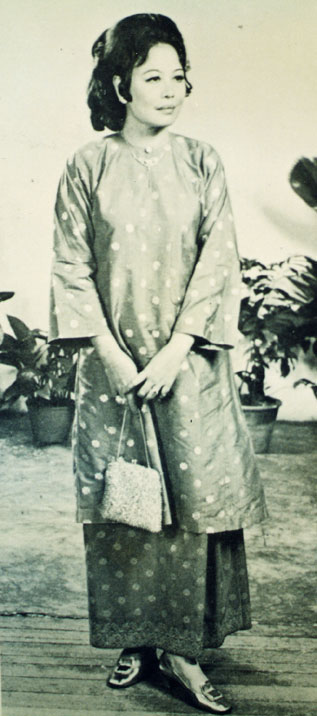
Baju Kurung is a traditional attire of Malays and traditionally worn by women in Brunei, Indonesia, Malaysia, Singapore and southern Thailand. This type of traditional attire is the national dress of Brunei and Malaysia. In Indonesia, this dress is also worn as a regional attire, commonly observed on the island of Sumatra, particularly by the ethnic Malay and Minangkabau women.

The national costume of Indonesia is the national attire that represents the Republic of Indonesia. It is derived from Indonesian culture and Indonesian traditional textile traditions. Today the most widely recognized Indonesian national attires include batik and kebaya, although originally those attires mainly belong within the island of Java and Bali, most prominently within Javanese, Sundanese and Balinese culture. Since Java has been the political and population center of Indonesia, folk attire from the island has become elevated into national status.
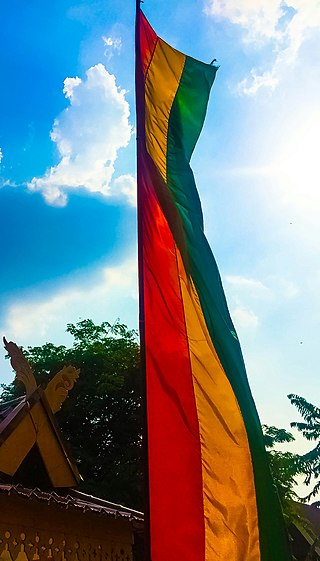
Malayisation or Malayization is a process of assimilation and acculturation, that involves acquisition or imposition of elements of Malay culture, in particular, Islam and the Malay language, as experienced by non-Malay populations of territories fully controlled or partially influenced by historical Malay sultanates and modern Malay-speaking countries. It is often described as a process of civilisational expansion, drawing a wide range of indigenous peoples into the Muslim, Malay-speaking polities of Maritime Southeast Asia. Examples of Malayisation have occurred throughout Asia including in Brunei, Cambodia, Indonesia, Malaysia, Singapore, and Sri Lanka.
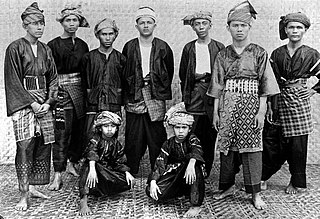
Tengkolok, also known as Tanjak, Destar is a traditional Malay or Indonesian and male headgear. It is made from long songket cloth folded and tied in a particular style (solek). Nowadays, it is usually worn in ceremonial functions, such as royal ceremonies by royalties, and wedding ceremonies by grooms.
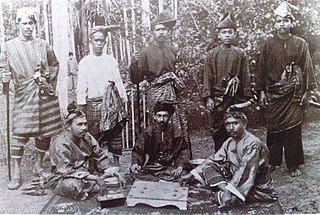
Pahang Malays are a sub-group of Malay people native to the state of Pahang, in the east coast of Peninsular Malaysia. With population of approximately 1.08 million people, they constitutes 70% of Pahang state's population, making them the dominant ethnic group in the state. Their language, Pahang Malay is one of many Malayan languages spoken in the region that belong to the Malayo-Polynesian group of Austronesian family.
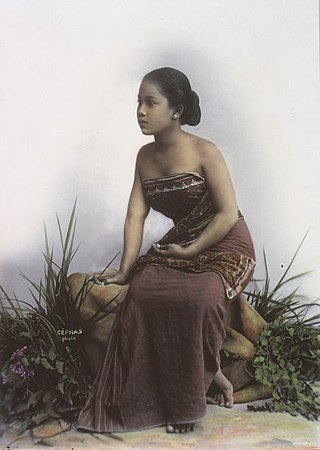
Kemben is an Indonesian female torso wrap historically common in Java, Bali, and other part of Indonesian archipelago. It is made by wrapping a piece of kain (clothes), either plain, batik printed, velvet, or any type of fabrics, covering the chest wrapped around the woman's torso.
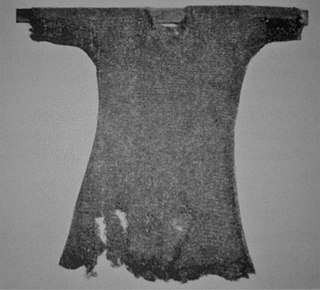
The Baju Rantai is a type of armor from Nusantara archipelago.

Samping or Kain Dagang is a traditional Malay costume originated from the court of Malacca, and is traditionally worn by men and women in Brunei, Malaysia, Indonesia, Singapore and southern Thailand. This type of traditional costume is a part of the national dress of Brunei and Malaysia.

